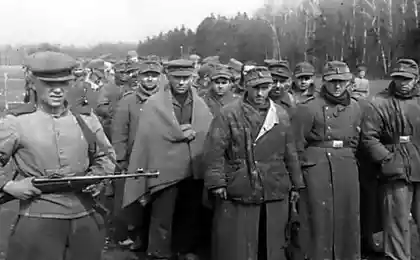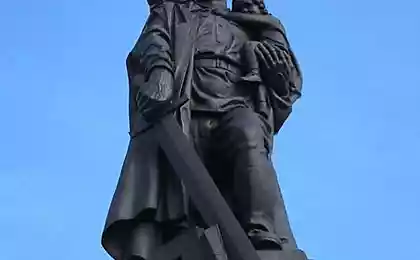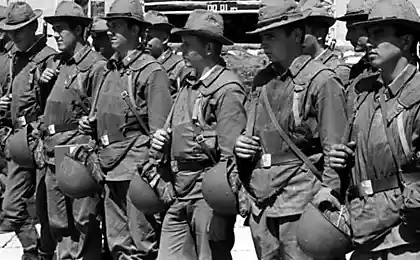1565
Truth and lies about the Soviet prisoners of war

The tragic fate of Soviet soldiers caught during the Great Patriotic War in the enemy prisoner, has long been one of the favorite themes for unscrupulous speculation. If you believe the democratically oriented publicists, our POWs died in German concentration camps only because that monster, Stalin has not signed the Geneva Convention. Well, almost all of the survivors, of course, immediately after the liberation was immediately sent to the Gulag.
Although previously secret archives are open for a long time, and serious study of the fate experienced the bitterness of slavery there were many soldiers, reformers totalitarian past are not appeased. Using TV privatized, they continue from month to month splashes from the screen his horror stories.
The impotence of the Geneva Conventions
Shortly before the attack on the Soviet Union held on March 30, 1941 meeting of the administrative board of the Wehrmacht, Hitler clearly stated: "We are talking about the fight for destruction. If we do not look well, although we will divide the enemy, after 30 years of communist danger arises again ... "(F. Halder War Diary. V.2. Moscow, 1969. S.430).
Following the instructions of the Fuehrer, the Commander of the 4th Panzer Group Erich Hoepner the upcoming fighting in the east in a special order on May 2, 1941, wrote that the coming war "should aim to turn into ruins today's Russia, and therefore it should be conducted with unprecedented cruelty "(The bodies of state security of the USSR in the Great Patriotic War. Vol.1. eve. Book 2. January 1 - June 21, 1941 Moscow, 1995. S.338).
One manifestation of this "unspeakable brutality" was the mass murder of our prisoners of war. During the war the Germans destroyed 57% got them captured Soviet soldiers. For comparison of the captured us 3576, 3 thousand soldiers of the German Armed Forces have died in captivity 442, 1 thousand (12, 4%), and 800 thousand soldiers of the armies of the Allies in Germany on the Soviet-German front (Hungary, Italy, Romania, Finland, Slovakia) - 137, 8 thousand (17, 2%).
Quite a different attitude to the Germans captive out of enlightened Europe. So, from 1547 thousand. French soldiers and officers who have appeared in the summer of 1940 in the German captivity, died or were killed a total of 40 million, or 2, 6%.
Who should be responsible for the destruction of our prisoners of war? It would seem that the question is purely rhetorical. Of course, the leadership of the Third Reich under Hitler, gave the criminal orders. But it was not there! According to the popular version of the current truth-seekers, to blame again Stalin:
"Stalin, saying:" We have no prisoners of war, there are traitors "- outlawed by millions of people. Rejection of the Geneva Convention on prisoners of war and from the payment of money to the Red Cross doomed Soviet people in the mass extermination in Nazi camps "(Eve and the beginning of the war: Documents and materials / Comp. L.A.Kirshner. L., 1991. P.39) .
But let's not be lazy to look in the text of encases 27 July 1929 in Geneva Convention on prisoners of war:
"Article fourth.
Power, which has taken prisoners of war, obliged to take care of their content ...
Article eighty-second.
The provisions of this Convention shall be met by the High Contracting Parties in all circumstances.
If in case of war, one of the warring parties will not Parties to the Convention, however such provisions are binding on all belligerents, signatories to the Convention »
(Prisoners of war in the Soviet Union. 1939-1956. Documents and Materials. Moscow, 2000. S.1012, 1024-1025).
As you can see, from the text of the Geneva Convention unequivocally shows that, firstly, the cost of maintaining prisoners carries the state of their capture. Secondly, the State party to the Convention are obliged to comply with it regardless of whether the convention signed his opponent. Germany signed the Geneva Convention.
I must say that the Nazi leadership clearly understood this legal point, so to justify their criminal actions floats standard propaganda cliches. From the order of the treatment of Soviet prisoners of war in all prisoner of war camps on September 8, 1941:
"Bolshevism is the mortal enemy of National Socialist Germany. For the first time in front of the German soldier is the enemy, trained not only in the military but also in the political sense, in the spirit of destructive Bolshevism. The fight against National Socialism in his blood. He leads her by all means at its disposal: sabotage, demoralizing propaganda, arson, murder. Therefore, the Bolshevik soldiers lost all right to apply for treatment as a honest soldier, in accordance with the Geneva Agreements "(Organs of State Security of the USSR in the Great Patriotic War. V.2. Home. Book 2. September 1 - December 31, 1941. Moscow, 2000 . S.507).
Four percent for GULAG
Oplёvyvayuschie past of our country's writers together paint a harrowing picture of how the former Soviet soldiers liberated from German concentration camps, almost without exception were sent to the Gulag camps or at least in battalions:
"After the war ferocity shook me to the prisoners. For what? From Hitler's death camps - in Stalin's concentration camps. Only Georgy Zhukov tried to intercede for three unhappy people, but in vain. Sam and fell into disgrace "(Yakovlev AN Zhirinovsky and other" patriots "in the fatty quotes // News. 25 April 1995. №76 (24435). C.5).
In fact, elementary common sense dictates that soldiers returning from captivity, should be subjected to inspection bodies of counterintelligence - if only because, among them certainly there are a number of enemy agents. The Germans made extensive use of this channel to infiltrate its agents. Here's what I wrote about this in his memoirs, the chief of RSHA VI Brigadeführer SS Walter Schellenberg:
"In the prison camps were selected by thousands of Russian, which after training on parachutes throwing deep into Russian territory. Their main task, along with the transfer of current information, it was the political decomposition of the population and sabotage. Other groups were intended to fight the guerrillas, which they threw in as our agents to the Russian partisans. To quickly achieve success, we began to recruit volunteers from the Russian POW right in the front line "(W. Schellenberg Memoirs / Trans. From German. M., 1991. p.215).
Thus, the creation in late 1941 on the orders of Defence Commissar №0521 filtration camps to check liberated from captivity was a necessity.
Check these special camps were not only former prisoners of war. Arrives to the contingent was divided into three groups of usernames:
1st - prisoners of war and encirclement;
2nd - the rank and file police officers, village headmen and other civilians suspected of treasonable activities;
3rd - civilians of military age, residing in the territory occupied by the enemy.
But maybe from the filtration camps former prisoners en masse really drove the Kolyma? Let's analyze published on this account historical data:
"Help on the audit b / encircled and b / prisoners as of October 1, 1944
1. To test the former Red Army soldiers held captive or surrounded by the enemy, the decision on GFCS №1069ss 27.XII-'41 set up special camps of the NKVD.
Check in special camps are soldiers of the Red Army carried out counterintelligence departments "Smersh" NGOs in the special camps of the NKVD (at the time this decision was special departments).
Total passed through special camps of former Red Army soldiers who came out of encirclement and liberated from captivity, 354,592 people., Including officers of the 50,441 attendees.
2. Of these, tested and delivered:
a) the Red Army 249,416 people.
including:
military units through military enlistment offices 231 034
of them - officers 27,042
the formation of the assault battalions 18 38
of them - officers 16,163
b) in the industry according to the judgments of the GFCS 30,749
including - 29 officers
c) the formation of the convoy of troops and protection of special camps 5924
3. arrested by the "Smersh" 11,556
of them - intelligence agents and counter enemy
2083 of them - officers (for various offenses) in 1284
4. departed for various reasons, for all the time - in hospitals, infirmaries and died 5347
5. Are special camps in the Soviet NKVD in check 51,601
Including - officers
5657 Of those remaining in the camps of the NKVD officers in October formed 4 assault battalion of 920 men each, "(VN Zemskov Gulag (historical and sociological aspect) // Sociological Research. 1991. №7. S.4-5). < br />
So the fate of former POWs authenticated before October 1, 1944 are as follows:
Sent
military units through military enlistment offices: 231034 people (76, 25%)
in the assault battalions: 18382 people (6, 07%)
in industry: 30,749 persons (1, 96%)
in the escort troops: 5924 persons (0, 15%)
11556 arrested man (3, 81%)
in hospitals, infirmaries, died: 5347 people (1, 76%)
Total has been tested: 302,992 people (100%)
Thus, as can be seen from the cited references, including privates and sergeants successfully tested by more than 95% (or 19 out of 20) of former prisoners of war.
Somewhat different was the case with having been in captivity officers. Arrests are less than 3%, but in the summer of 1943 until the autumn of 1944, a significant proportion channeled as privates and sergeants in the assault battalions. And this is quite understandable and justified - to the officer asked more than ordinary.
In addition, we must note that the officers got in battalions and atone, restored in rank. For example, the 1st and 2nd assault battalions formed by August 25, 1943, within two months of fighting have shown themselves from the best side and the Order of the NKVD were disbanded. Fighters of these units to restore the rights, including the officers, and then sent to fight later in the Red Army.
In November 1944, the GKO adopted a decree according to which the liberated prisoners of war and Soviet citizens of military age until the end of the war were sent directly to the replacement of the military, bypassing the special camps. Among them were, and more than 83 thousand officers. Of these, after verifying 56160 people were dismissed from the army, more than 10 thousand sent to the troops in 1567 deprived of officer ranks and demoted to private, 15,241 transferred to the rank and file (Shabayev AA losses officers of the Red Army in World War II (Military Historical Archive. 1998. №3. p.180).
So, after getting acquainted with the facts, including those published by notorious anti-Stalinists, the myth of the tragic fate of the liberated Soviet prisoners burst like a soap bubble. In fact, until the end of the war, the vast majority (over 90%) of Soviet soldiers liberated from German captivity, after the necessary checks in the NKVD special camps back into operation or were sent to work in the industry. A small number (4%) were arrested and about the same aims in the battalions.
The NKVD special camps
It is very popular among the myth-makers is the assertion that a liberated Soviet prisoners of war in the Soviet Union were treated worse than taken prisoner by the Germans.
For example, here is what M.I.Semiryaga: "If we talk about the paradox in relation to the position of Stalin and his entourage against the prisoners of war, it was that the Soviet leadership treated more humanely enemy prisoners of war, rather than to their own citizens, returned from the captivity of the enemy "(Semiryaga MI Prison Empire of Nazism and its collapse. M., 1991. p.131).
Meanwhile, in order to determine who to treat more, and to whom at least humanely, there is such a simple and obvious indicator as mortality.
Here are the figures for the July-December 1944 Journal of statistical account of presence and movement contingent in special camps of the NKVD of the USSR, where there were liberated Soviet prisoners of war (GARF. FR-9408s. Op.1s. S.13. L.1-18) (See Table. 1)
Now let's see, what was the mortality of the Germans and their allies in our captivity. Here is the data from the report in the name of Stalin Beria and Molotov on the number of prisoners of war contained in the NKVD camps, and their physical condition and the distribution of work in the People's Commissariat. According to this document, on December 5, 1944 we were in captivity 680,921 troops of the enemy. Thus for the last ten days of November in POW camps and died 6017 in hospitals in 2176 people (prisoners of war in the Soviet Union. 1939-1956. Documents and materials ... S.591-592). That is, 10 days 8193 prisoners died, or 1, 2%.
For comparison, in 15 special camps of the NKVD, which in the aforementioned magazine statistical accounting there is evidence in the last decade of November of 120 thousand tested liberated Soviet prisoners of war and other contingent (at the beginning of the last decade of them there were 123,765 at the end of the decade - 119 859) died only 41 people (GARF. FR-9408s. Op.1s. S.13. L.1-18) or 0, 03%.
However, do not think that the NKVD specifically sought to kill more prisoners of the Germans, Romanians, Italians (and other citizens of the then united Europe, which were the barbaric Russia attach to Western civilization). As noted in the same help to Beria: "In October and November of this year the camps received 97,000 prisoners, mostly from Chisinau in the area surrounded by groups of enemy troops. More than half of them were exhausted and sick. Despite the measures for their rehabilitation, deaths of prisoners of war ended in October and November rose sharply "(prisoners of war in the Soviet Union. 1939-1956. Documents and materials ... S.592).
However, there were Soviet prisoners of war freed in special camps of the NKVD too far from health centers. Nevertheless, the mortality rate among them was ten times smaller.
No less interesting to compare mortality liberated Soviet prisoners of war detained in special camps of the NKVD, with a mortality rate of prisoners in Soviet prisons and labor camps. In 1944 it amounted to 8, 84% in the camps of the Gulag and 3, 77% in prisons. I think we can now fully assess the "good faith" of those writers who equate the passage verification NKVD special camps to imprisonment in the Gulag, as did, for example, a certain Mark Steinberg in his article recently published in the "Independent Military Review": "More than one and a half million men in the country lost a considerable part of this particular component of its demographics, were isolated in so-called filtration centers. Their conditions were no different from the Gulag and a considerable part of the "filtered" lost "(M. Steinberg When the word" prisoner of war "sounds proudly // Independent Military Review. 14-20.01.2005. №1 (409). C.8).
FLIGHT FROM HELL
A striking example of the fate of a Soviet officer, who returned from German captivity, is the history of fighter pilot Vladimir Dmitrievich Lavrinenkova.
May 1, 1943 he was awarded the title Hero of the Soviet Union. August 23, 1943 senior lieutenant rammed a German plane Lavrinenkov, after which he was forced to jump out with a parachute over the territory occupied by the enemy, and was captured. He was sent to Berlin for interrogation, but in a way he and another pilot, Victor Karyukin, jumped out of the night going at full speed of the train and disappeared. Making his way to the front lines, the pilots ran into guerrilla unit named VIChapaev in force in the area of Pereiaslav, and joined him.
In one of the fights Victor Karyukin died. Lavrinenkov same within three months he fought as a partisan, and after the arrival of the Red Army returned to his regiment. Contrary to stereotypes of anti-Stalinist propaganda, he was not subjected to any reprisals. He was awarded the military rank and 1 July 1944 Lavrinenkov became twice Hero of the Soviet Union.
His escape was struck by the Germans so that they later wrote about the brave pilot of the most incredible legends. It was said that one day, shot down an enemy aircraft, Lavrinenkov landed, grabbed the German pilot, parachute jumped off and strangled him. Of course, none of this nonsense really was not.
Later Vladimir Dmitrievich also not subjected to any harassment of their captivity. In 1948 he graduated from the Military Academy. Frunze, in 1954 - the Higher Military Academy. KE Voroshilov and finished his career with Colonel-General.
Equally revealing the fate of another pilot, who visited the German captivity - Mikhail Petrovich Devyataeva. July 13, 1944 Senior Lieutenant Devyatayev was shot down and captured. After some time, he found himself in a concentration camp on the island of Usedom. February 8, 1945 a group of 10 Soviet prisoners made a daring escape, captured German bomber "Heinkel-111". After two hours of flight of the aircraft, piloted Devyataeva, he sat down in the arrangement of the Soviet troops.
No.























